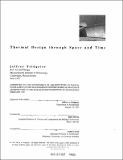Thermal design through space and time
Author(s)
Feldgoise, Jeffrey
DownloadFull printable version (21.06Mb)
Advisor
Julie Dorsey.
Terms of use
Metadata
Show full item recordAbstract
One of the primary roles of architecture is to control the environment at the service of a building's inhabitants. Thermal qualities are a significant factor in the overall experience one has inside and outside a building. However, thermal issues are not often considered within the context of the architectural design process, resulting in buildings that are not responsive to thermal concerns. Heat has the potential to influence the form of architectural space. The methods by which architects can use thermal energy as a formative element in design is open to further exploration. In this thesis, I explore new methods for architects to describe thermal intentions and visualize thermal qualities of design proposals. Beyond the economic issue of energy conservation, the thermal qualities of building spaces affect the quality of human inhabitation. The capability to describe and visualize heat would allow architects to adjust the building's thermal characteristics to modify a person's experience of the place. With a more complete understanding of thermal qualities of their building proposals, architects would be able to design for the complete gamut of thermal sensations that humans can experience. What is needed is a working vocabulary that describes the range of thermal conditions possible in buildings. In this work, I describe a vocabulary for a building's thermal qualities using four sets of measurable, opposing terms: open versus protected, bright versus dim, warm versus cool, and active versus still. Next, I then articulate the thermal qualities of a co-housing project to create a thermal experience that enhances the community aspects of co-housing. Using a variety of visualization techniques, I verify that the design proposal is achieving the intended thermal goals. Using the knowledge gained from this and future thermal design exercises, we can begin to reflect on the general relationships between thermal phenomena and physical building forms, learning about the thermal qualities of architecture.
Description
Thesis (M. Arch.)--Massachusetts Institute of Technology, Dept. of Architecture, 1997. Includes bibliographical references (p. 89-90).
Date issued
1997Department
Massachusetts Institute of Technology. Department of ArchitecturePublisher
Massachusetts Institute of Technology
Keywords
Architecture